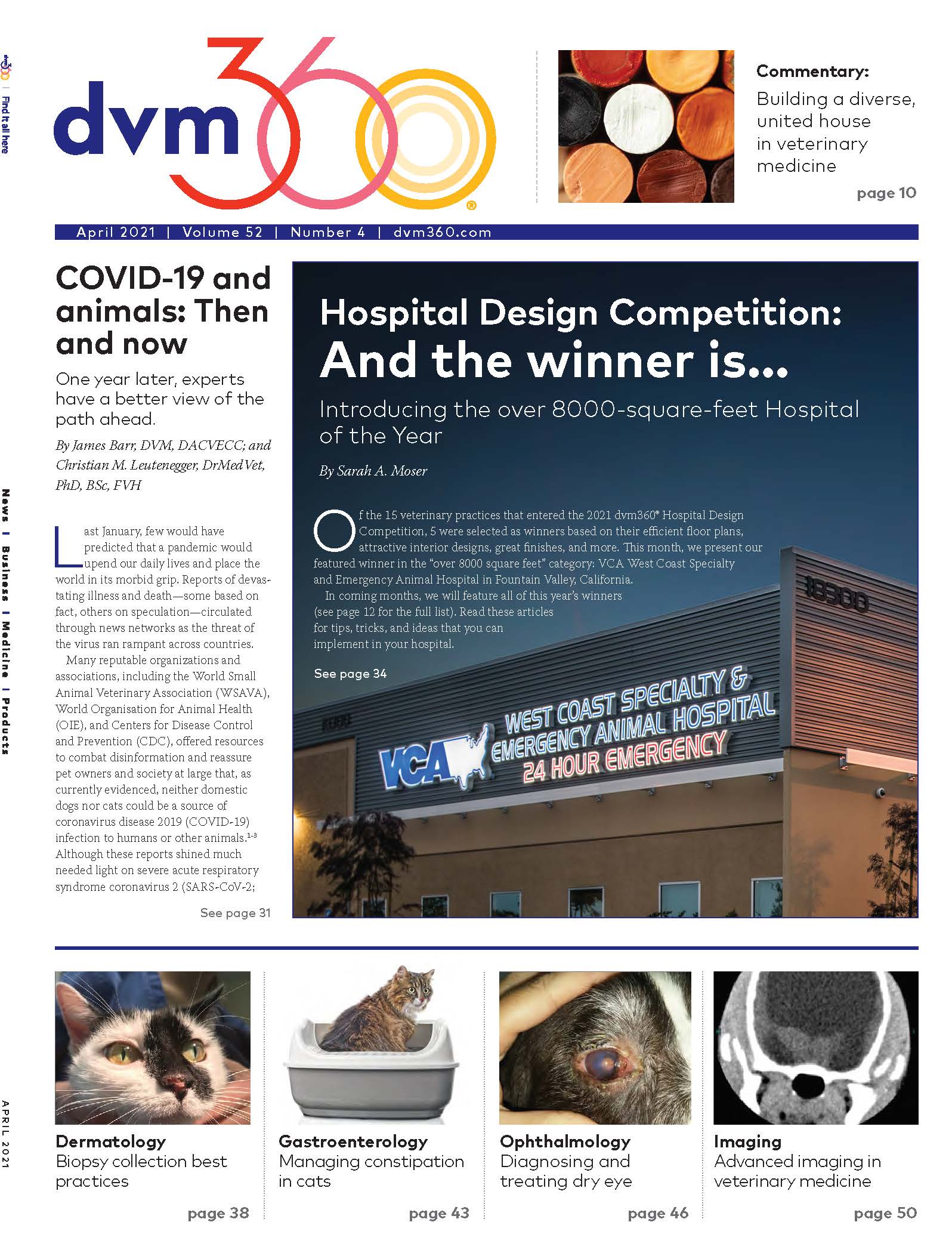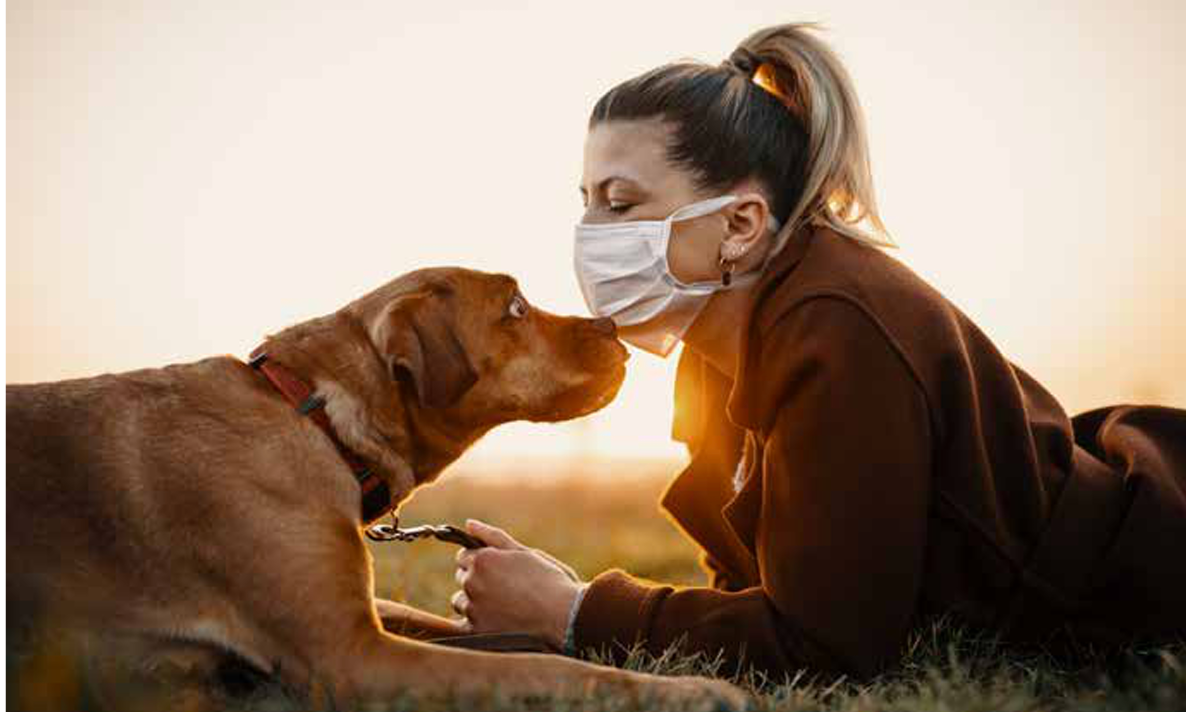COVID-19 and animals: Then and now
One year later, experts have a better view of the path ahead.
Last January, few would have predicted that a pandemic would upend our daily lives and place the world in its morbid grip. Reports of devastating illness and death—some based on fact, others on speculation—circulated through news networks as the threat of the virus ran rampant across countries. Many reputable organizations and associations, including the World Small Animal Veterinary Association (WSAVA), World Organisation for Animal Health (OIE), and Centers for Disease Control and Prevention (CDC), offered resources to combat disinformation and reassure pet owners and society at large that, as currently evidenced, neither domestic dogs nor cats could be a source of coronavirus disease 2019 (COVID-19) infection to humans or other animals.1-3 Although these reports shined much needed light on severe acute respiratory syndrome coronavirus 2 (SARS-CoV-2; the virus that causes COVID-19) in pets as an emerging disease event, many questions were left unanswered. However, as time passes and more research becomes available, experts are gaining a clearer understanding of SARS-CoV-2, including how different animals can be affected or not by COVID-19, and the path ahead.
What we know
Although the initial infections were linked to the Huanan Seafood Wholesale Market in Wuhan, China, public health officials and partners continue to work on identifying the source of COVID-19 to better understand where the virus originated and how it spread across species into humans. Experts do suspect it originally came from animals, likely bats and pangolins.
Bats, rodents, pigs, and birds in general are considered high-risk viral reservoirs, a source for diseases that can jump to humans and sometimes lead to epidemics. Some scientists have argued that bats and rodents have certain traits that increase the likelihood of spillover events from animals to people, but evidence of this is inconclusive.4 Considering that bats harbor several viruses that cause severe disease in people, including rabies, it makes sense that they—along with other animal reservoirs—continue to be the focus of most viral-detection and surveillance efforts across the world.
SARS-CoV-2 is part of a large family of coronaviruses. Whereas some coronaviruses have the potential to cause disease in humans, others can cause illness in animals such as bats and cattle.5 Dogs and cats have their own species-specific coronaviruses, but they have not been shown to infect people.
In rare cases, animal coronaviruses jump across the species barrier into humans and then spread between people. Possible modes of transfer of zoonotic infections include aerosolization, droplet spray, ingestion (oral), direct contact (animal, bodily fluids), indirect contact (eg, fomite, contaminated tools and surfaces, or other objects in the environment), or vector-borne transmission of infectious agents.6
The genetic makeup of a virus is an important factor in how an infectious disease is transmitted from one species to another. SARS-CoV-2 uses a specific protein (angiotensin-converting enzyme 2 [ACE2] receptor) to attach to human cells and then cause an infection. If the gene that makes the ACE2 receptor protein is different in another species, attachment and infection cannot occur.
Zoonotic diseases
Zoonotic diseases are very common. In fact, 60% of existing human infectious diseases are zoonotic and 75% of emerging human diseases have an animal origin.7 Examples of diseases caused by coronaviruses that originated in animals and spread to humans are SARS virus and Middle East respiratory syndrome.
Ebola virus disease, formerly known as Ebola hemorrhagic fever, is also zoonotic; however, the extent to which it affects animals is not well known. Scientists believe the first patient with Ebola became infected through contact with an infected animal, such as a fruit bat or primate.8 This is called a spillover event. Person-to-person transmission follows a spillover event and can lead to large numbers of affected persons. In the West African Ebola virus epidemic, animals were not found to be a factor in ongoing transmission.9
Although public health officials and other experts still do not know the exact source of SARS-CoV-2, as we already understand it, zoonotic transmission is suspected to have caused the human coronavirus outbreak of 2019.
COVID-19 and animals
Based on what we know now, and what is known about other coronaviruses, domestic dogs or cats are not considered to be a source of COVID-19 infection in humans or other animals, and there is limited evidence to support a risk of the virus spreading among pets in the home. Although there have been reports of human-to-animal transmission in pets belonging to people with COVID-19, they continue to be sporadic. Currently, the largest known SARS-CoV-2 transmission risk is from person to person through respiratory droplets from coughing, sneezing, and talking, not between pets or from people to pets.
A small number of animals worldwide have been reported to be infected with SARS-CoV-2, mostly after close contact with people diagnosed with COVID-19. Common during large-scale outbreaks such as COVID-19, spillback or “reverse” zoonotic transmission from human to animals is a risk. This phenomenon has been illustrated by 2 COVID-19 outbreaks in mink on farms in the Netherlands. Spillback of SARS-CoV-2 has also been observed from pet owners to domestic dogs and cats and from humans to tigers and lions in zoos.10,11 As of January 15, 2021, this number in the US was at 131 and consisted of cats (58), dogs (41), minks (16), tigers (7), lions (3), gorillas (3), and snow leopards (3).12 Of the animals reported to be positive, most showed mild signs of illness.
In the limited confirmed cases of SARS-CoV-2 in domestic dogs and cats, there have been reports of mild respiratory or gastrointestinal signs in about half of those cases, the other half being symptom free. Although there is still little evidence that pets can be a source of infection to other animals or to humans in a domestic environment, our current understanding is that cats have similar receptors to humans for SARS-CoV-2. To this point, laboratory results have shown that cats can transmit the virus to other cats. Like humans, though, cats may have differing responses to viral exposure, with some being more susceptible than others.
Mink and other weasels (mustelids) are also known to be easily infected Ultimately, the risk for humans being infected by any means besides other humans is considered minimal. The key when managing pets with respiratory or gastrointestinal disease, particularly those with acute onset and who are owned by individuals diagnosed with COVID-19, is to take precautionary measures. Any surface with which a person infected with COVID-19 comes into contact, including pet fur or nasal secretions, may transfer the virus (viral RNA itself is not infectious). As animal handlers, we should keep all pets and other animals away from infected humans and continue to practice good hygiene.
COVID-19 testing and vaccines for pets
SARS-CoV-2 is an RNA virus, meaning the genetic material for SARS-CoV-2 is encoded in RNA. This viral RNA is clever in that its genetic makeup causes the protein synthesis mechanism in humans to detrimentally mistake it for RNA produced by our own DNA. Therefore, many COVID-19 vaccines and treatments are founded on RNA technologies.
Although effective testing and human vaccines have become available, the CDC, US Department of Agriculture (USDA), AVMA, and other human and veterinary health organizations do not recommend vaccines for or routine testing of animals for the virus at this time.13-15 If a pet is showing signs of SARS-CoV-2 and/or the owner has tested positive for COVID-19, some veterinary hospitals may pursue testing for the pet; however, these instances are extremely rare. Experts maintain that SARS-CoV-2 is a human virus and, based on the limited information available to date, the threat to animals and risk of animals spreading COVID-19 to people is low.
Based on a lack of data and evidence of transmission and clinical disease in other species, the USDA is accepting applications for a SARS-CoV-2 vaccine in mink given the recent outbreaks, but is not yet accepting applications for one in dogs and cats.16 The USDA is closely monitoring the situation and may re-evaluate as more information becomes available.
The path forward is knowledge and prevention
Historic epidemics have taught us that federal- and state-mandated guidelines and protocols, including increased hand sanitation, mask-wearing, and social distancing, as well as the swift development of vaccines, decrease (if not halt) virus transmission. As experts discover more about how this virus spreads, including virus variants, the essential workers who support public health through veterinary care will be better equipped to treat and combat the spread of SARS-CoV-2 among vulnerable populations.
As we look to the future, the international research and global health community must also continue to consider how other factors, such as factory farming, wildlife trade, and environmental changes, may push animals into contact with more people and influence the emergence of viruses. Increased surveillance efforts directed at the “fault lines,” where there is high human-animal interaction, may be most beneficial in the prevention of a future spillover.
James Barr, DVM, DACVECC, is chief medical officer (CMO) for BluePearl Specialty and Emergency Pet Hospital. Barr obtained his veterinary degree from Louisiana State University in Baton Rouge. He was a criticalist at Florida Veterinary Specialists (BluePearl’s original hospital), then left to teach at Texas A&M University in College Station, returning to BluePearl in 2017. As CMO, he oversees medical operations of BluePearl’s 100+ practices.
Christian M. Leutenegger, DrMedVet, PhD, BSc, FVH, is director of molecular diagnostics at Antech Diagnostics. He graduated from the University of Zurich Vetsuisse Faculty in Switzerland and completed a PhD on developing the first DNA vaccines in veterinary medicine. He established early protocols for DNA quantification and founded the Molecular Core Facility at the University of California, Davis, School of Veterinary Medicine. After 13 years at Idexx Laboratories, he joined Antech to expand the company's infectious disease, cancer and genetic diseases molecular diagnostics.
References
- COVID-19—advice and resources. World Small Animal Veterinary Association. March 18, 2020. Accessed March 13, 2021. https://wsava.org/news/highlighted-news/the-new-coronavirus-and-companion-animals-advice-for-wsava-members/
- Questions and answers on COVID-19. World Organisation for Animal Health. January 22, 2021. Accessed March 13, 2021. https://www.oie.int/en/scientific-expertise/specific-information-and-recommendations/questions-and-answers-on-2019novel-coronavirus/
- How COVID-19 spreads. Centers for Disease Control and Prevention. October 28, 2020. Accessed March 13, 2021. https://www.cdc.gov/coronavirus/2019-ncov/prevent-getting-sick/how-covid-spreads.html?CDC_AA_refVal=https%3A%2F%2Fwww.cdc.gov%2Fcoronavirus%2F2019-ncov%2Fabout%2Findex.html
- Calisher CH, Childs JE, Field HE, Holmes KV, Schountz T. Bats: important reservoir hosts of emerging viruses. Clin Microbiol Rev. 2006;19(3):531-545. doi:10.1128/CMR.00017-06
- COVID-19 and animals. Centers for Disease Control and Prevention. February 10, 2021. Accessed March 13, 2021.
- van Seventer JM, Hochberg NS. Principles of infectious diseases: transmission, diagnosis, prevention, and control. International Encyclopedia of Public Health. 2017;22-39. doi:10.1016/B978-0-12-803678-5.00516-6
- One Health. World Organisation for Animal Health. Accessed March 13, 2021. https://rr-europe.oie.int/en/our-missions/one-health/
- Leroy EM, Epelboin A, Mondonge V, Pourrut X, Gonzalez JP, Muyembe-Tamfum JJ, Formenty P. Human Ebola outbreak resulting from direct exposure to fruit bats in Luebo, Democratic Republic of Congo, 2007. Vector Borne Zoonotic Dis. 2009;9(6):723-728. doi:10.1089/vbz.2008.0167
- Ebola virus disease. World Health Organization. February 23, 2021. Accessed March 13, 2021. https://www.ncbi.nlm.nih.gov/pmc/articles/PMC1539106/https://www.who.int/news-room/fact-sheets/detail/ebola-virus-disease
- Sit THC, Brackman CJ, Ip SM, Tam KWS, Law PYT, To EMW, et al. Infection of dogs with SARS-CoV-2. Nature. 2020;586(7831):776-778. doi:10.1038/s41586-020-2334-5
- Newman A, Smith D, Ghai RR, et al. First reported cases of SARS-CoV-2 infection in companion animals—New York, March-April 2020. MMWR Morb Mortal Wkly Rep. 2020;69(23):710-713. doi:10.15585/mmwr.mm6923e3
- Cases of SARS-CoV-2 in animals in the United States. USDA Animal and Plant Health Inspection Service. Accessed March 13, 2021. https://www.aphis.usda.gov/animal_health/one_health/downloads/sars-cov2-in-animals.pdf
- Evaluation for SARS-CoV-2 testing in animals. Centers for Disease Control and Prevention. August 12, 2020. Accessed March 13, 2021. https://www.cdc.gov/coronavirus/2019-ncov/animals/animal-testing.html?CDC_AA_refVal=https%3A%2F%2Fwww.cdc.gov%2Fcoronavirus%2F2019-ncov%2Fphp%2Fanimal-testing.html
- FAQ on animal coronavirus testing. US Department of Agriculture. April 22, 2020. Accessed March 13, 2021. https://www.aphis.usda.gov/animal_health/one_health/downloads/faq-public-on-companion-animal-testing.pdf
- Testing animals for SARS-CoV-2. American Veterinary Medical Association. April 22, 2020. Accessed March 13, 2021.https://www.avma.org/resources-tools/animal-health-and-welfare/covid-19/testing-animals-sars-cov-2
- Center for Veterinary Biologics Notice 20-12. US Department of Agriculture. November 11, 2020. Accessed March 13, 2021. https://www.aphis.usda.gov/animal_health/vet_biologics/publications/notice20-12.pdf https://rr-europe.oie.int/en/our-missions/one-health/

